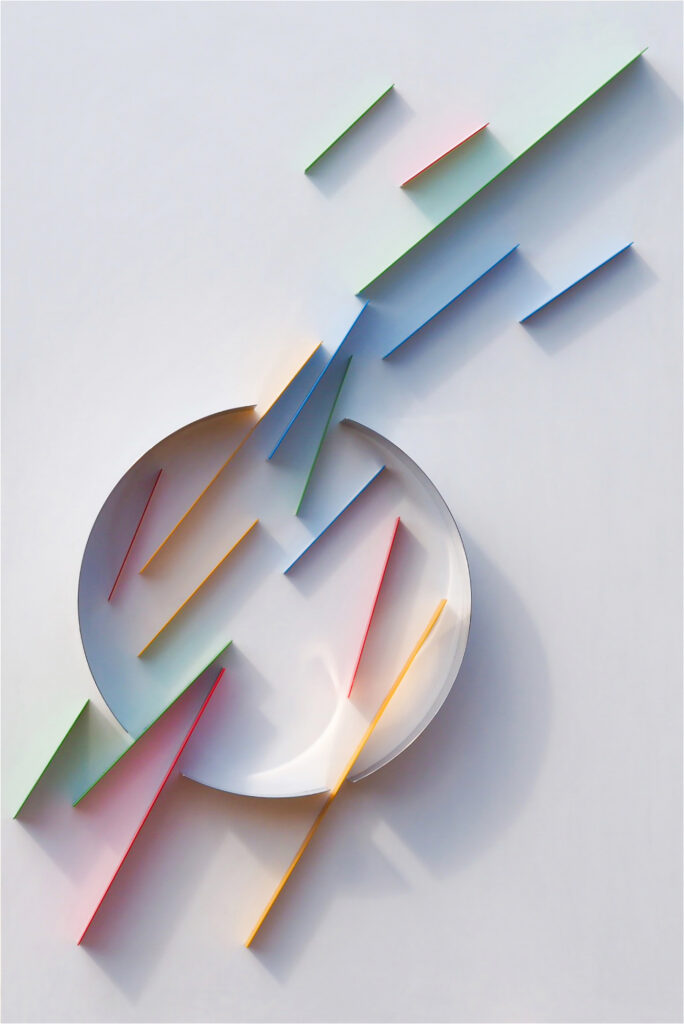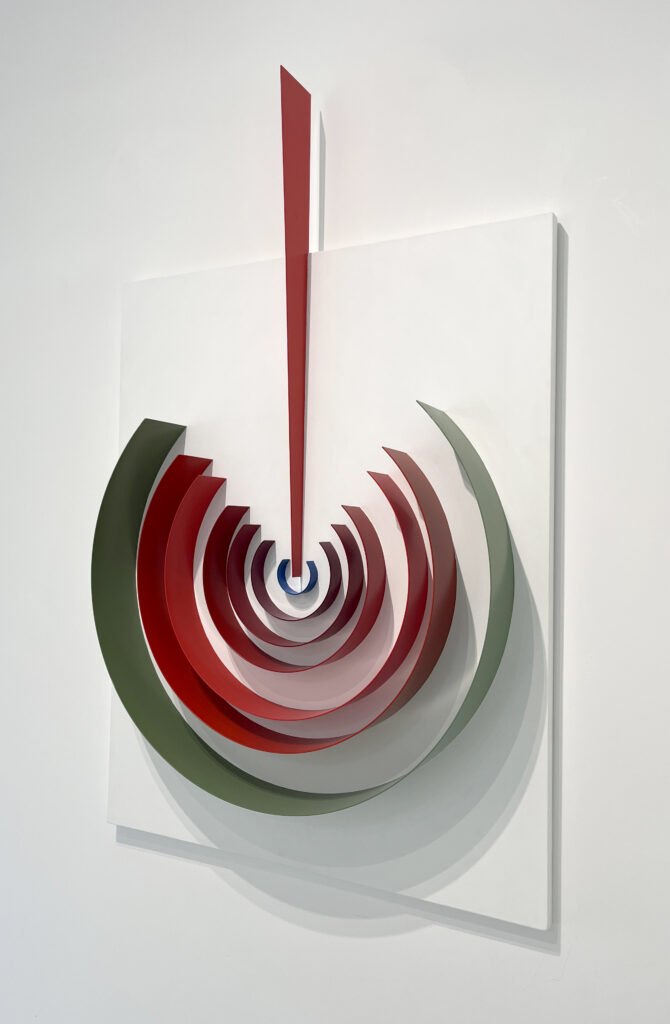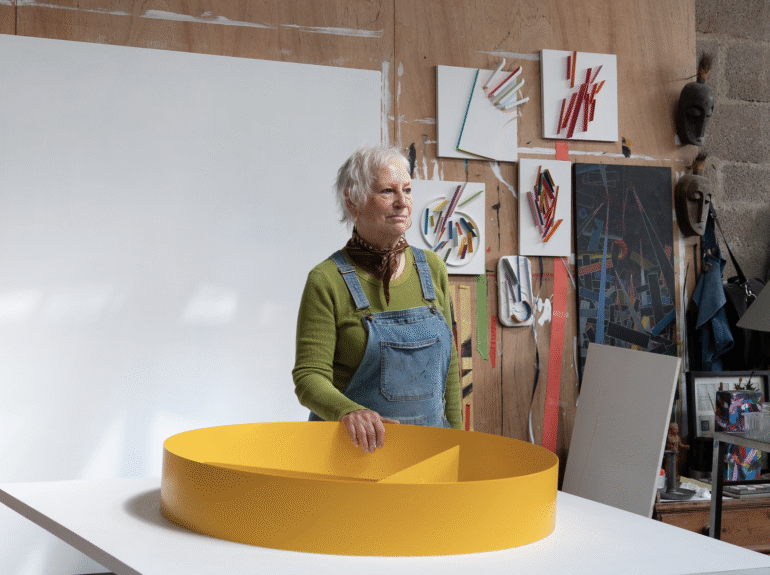To mark Suzanne Blank Redstone’s 80th birthday, CLOSE Gallery in Somerset is presenting Catching Light, a landmark exhibition celebrating six decades of the artist’s pioneering work in modernist and geometric abstraction.
Suzanne Blank Redstone (b. 1945 USA) has a BFA from Rhode Island School of Design (RISD) where she was selected for the European Honors Program in Rome 1965-6, and an MFA from the University of Pennsylvania School of Art and Architecture. She had a teaching fellowship there with Robert Engman, a protegee of Joseph Albers. In 1970 she left the USA for the UK and has been living and working alongside her husband on their farm in the countryside in Devon.
Rooted in the Bauhaus-inspired ideals of total art and shaped by movements like Op Art, Light and Space, and Geometric Abstraction, her work evokes both intellectual rigor and emotional resonance. In this interview, Redstone reflects on her creative evolution, the influence of nature and architecture on her practice, and the continued relevance of light as both medium and metaphor.
Opening on 10th May and running through 28th June, the exhibition offers a long-overdue survey of Redstone’s dynamic contributions to painting, sculpture, and public art. From her formative 1960s Portals series to recent large-scale light sculptures, Redstone has consistently pushed the boundaries of perception, exploring how light, geometry, and color can transform space and experience.
Culturalee caught up with Suzanne Blank Redstone as she prepared for a major solo exhibition at Somerset gallery CLOSE.

CLOSE Gallery was founded by Freeny Yianni, former Director of Lisson who believes that your work has been under recognised and that your vision should be spotlighted with this exhibition. How did the exhibition happen – did Yianni approach you and invite you to have a retrospective?
We met in the summer of 2023 in Cornwall at a private view of Royal Society of Sculptors group show that I was in. We got to know each other over several months and through visits to my studio and CLOSE Gallery. The relationship evolved with mutual admiration and respect. In the Autumn of 2024, Freeny offered to represent me and to put on an exhibition of my work at CLOSE in May 2025. I was pleased to accept.
How does it feel as an Octagenarian to be looking back at many decades of art making and seeing your oeuvre exhibited in this survey exhibition?
Fantastic – to be able to see and experience such a range of my work in one location at one time. As an artist, this is a rare event and gives me perspective on my work and my journey. I still feel that I’m at the beginning and I’m excited that there is so much still to explore.
You have had a long and prolific career creating artworks across a variety of medium including painting, sculpture, and public art. Do you have a favourite project or particular work that you have created?
Everything I have made has been part of my learning process. I’ve only made large works when I wanted to clarify or resolve what I was doing or when I was commissioned to construct a public art work. It is hard to pick out a favourite project or work. I get as much pleasure looking at one of my 1960’s Portal Paintings as I do on a piece that I finished last week.
If I had to pick a favourite – maybe the large installation that I created at the Porthcurno Telegraph Museum in Cornwall. It was inspired by a bit of technology at the museum – the mirror galvanometer.
What was the initial spark or inspiration behind the Catching Light exhibition and what inspired the title?
I think it was partly to show a wide range of my more recent work in one place for the first time, and also to be able to demonstrate from earlier work how I arrived at this point.
The title comes from a name I started giving my sculptures and 3 dimensional reliefs about 20 years ago–LIGHTCATCHERS. My works catch, reveal and interact with light.

How does light function as a central theme in this body of work? Are you referencing physical light, metaphorical light, or both?
Aristotle said “Light is the activity of what is transparent”. I work with natural light and create structures that provide environments to interact with its immediate surroundings–making changing visual activity both moment to moment and through the seasons.
I use light and form to engage the viewer in an open and unpredictable dialogue, working between nature and the built environment.
I’m interested in the physics of natural light as an artist. A while ago I was approached by physicists from Bristol University who had discovered my work and who were fascinated at how from our different starting points, we had arrived at a similar place.
Can you tell us more about your process—how do you begin a piece, do you work in a studio, what materials do you use, and how does each piece evolve?
Yes, I do much of my work in my studio. I work in long series with each small step informed by the one before. I tend to work small to explore and advance more quickly, making larger pieces when I need to clarify and resolve a phase of the work. Drawing is an essential part of my practice. I draw every day. It’s through drawing that my ideas develop.
How did the setting of Somerset or the gallery space influence this exhibition, if at all?
The gallery spaces at CLOSE are beautiful–the large gallery provides a lovely long area to see work, to slowly look, move and experience art. It has large window areas to interact with natural daylight and be close to nature. The smaller gallery spaces provide opportunity for the artist’s works to appear in more intimate settings. Large and small galleries together allow a rich narrative to develop during the visit.
You’re based in Devon and the exhibition is in Somerset. Does the rural or natural landscape around the gallery and your home resonate with and inspire the themes in your work?
Enormously. I’ve spent the past 50 years living and working in the Devon countryside. I am nourished and inspired by natural light and being surrounded by nature and close to the sea. I am influenced by natural forms and shapes and by the almost effortless beauty that I see all around me. My early work was produced in urban spaces – often lit by fluorescent lights.
Your work often deals with perception, atmosphere, and subtle shifts in the environment. What emotional or sensory experience are you hoping viewers take away from Catching Light?
I would hope that viewers become more sensitized to light, which is magical, mysterious and ever changing. It is so easy to take light for granted. I would like to inspire people to be intrigued with “how we see” rather than just with “what we see”.
As Josef Albers said: “I have not taught painting because it can’t be taught. I have taught seeing.”
Is there a particular piece in the exhibition that feels especially personal or pivotal to you?
If I had to pick one, I think it would be a large sculptural relief called ‘Passing Through’. It was inspired by my late father. For me, it’s life in many ways; what life and death have taught me. Life flowing in, life flowing through and life flowing on.
How does Catching Light fit within the broader arc of your artistic career? Do you see it as a continuation, a departure, or something else?
The Catching Light Exhibition gives me a window into my journey as an artist and thus also into myself. It feels very much like a continuation, but at the same time could well inspire new directions–I’ll have to wait and see! Suzanne Blank Redstone Catching Light is at CLOSE gallery, Close House, Hatch Beauchamp, Somerset from 10th May until 28th June, 2025.




